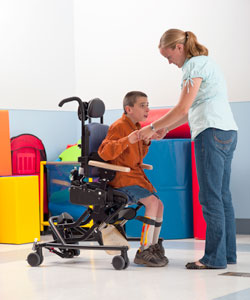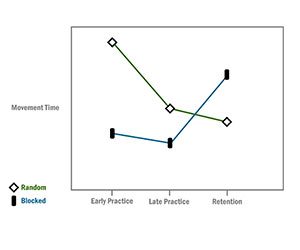This post continues our discussion begun last week, Motor Skills Learning & Practice part I, where we defined motor learning terminology, discussed the MOVE Curriculum (as an example of applied motor learning) and emphasized the importance of practice.
 Transfer-Appropriate Training
Transfer-Appropriate Training
One question that we must address is, “What should we practice?” This question clearly relates to the goals of therapy: the target behaviors which the person will need to perform in the future. As therapists we hope that the abilities acquired during our intervention will transfer over to functional activities outside of therapy. When we ask a child to maintain sitting balance on a therapy ball while responding to motion provided by the therapist, we presumably hope that this will lead to improved sitting balance in other functional situations, such as while sitting on a chair and reaching for something. Is this a realistic expectation? No! These are two different motor skill tasks. Sitting on the therapy ball requires the child to react to imposed motion to maintain balance, while the second task requires predictive control to maintain sitting balance during reaching. What can we say about transfer between tasks?
Clearly, the ideal way to learn a target behavior would be to practice that same behavior. Transfer-appropriate training relates to training in such a way that the amount of transfer to the target behavior is maximized. Carr and Shepherd give an excellent description of a motor relearning program for stroke designed to maximize transfer. Their program involves four steps:
1. Analysis of task
2. Practice of missing components
3. Practice of task
4. Transference of training
(Carr & Shepherd, 1987, p. 72)
Especially the last step, transference of training, gives increased opportunities for the learner to practice the skill in the natural contexts where it will be used. This basic scheme of a motor learning approach is certainly appropriate for children with severe disabilities as well, and it is very similar to the steps followed in the MOVE curriculum.
Practice Scheduling
Research in motor learning has shown that variations in practice scheduling may affect learning. Here we will look at two different factors: the amount of rest between practice trials (massed vs. distributed practice), and practicing a number of different tasks in random order or one at a time (blocked vs. randomized practice).
When practice is massed there is more time spent in work (actual practice than in resting between the trials. When a greater amount of time is spent in the rest periods than in practice trials, it is called distributed practice. The phenomena associated with practice distribution have been studied extensively in continuous tasks. In general, if the amount of time spent actually practicing remains the same, longer rest periods enhance performance and learning. (Schmidt, 1999) In other words, there are significant benefits to using distributed practice. Studies using retention and transfer tests have shown that there is a long-term learning effect from practice distribution, and that the difference is not only due to the fatigue experienced during massed practice. Note that distributed practice takes more time than massed practice, if the amount of work is to be kept constant. In discrete tasks (those with a clear beginning and end) the effects of distributed and massed practice are less clear. (Schmidt, 1999)
When an individual practices a number of motor skills activities, practice may be scheduled in a number of ways, including: blocked practice (drilling one activity for many repetitions) or random practice (alternating practice of the different activities during a session). A significant amount of research has focused on the different effects of these two methods of practice scheduling. This is one area where the performance/learning distinction is very important. If short-term performance changes only are measured, there is a significant benefit to blocked practice. As a subject acquires a skill, the performance

improves more rapidly with blocked practice than with random practice. However, retention tests show enhanced learning with random practice when the skills are tested after several minutes, hours or days have passed (Schmidt, 1991; Shea & Morgan, 1979) This may have clinical applications for our children who are attempting to learn motor skills. It may be necessary to practice a skill initially using blocked scheduling until the child begins to have some success at achieving the movement goal, but thereafter random practice should be more beneficial for long-term learning of the skill. See figure.
Material for this three-part series is excerpted from the book Children with Severe Disabilities and the MOVE Curriculum: Foundations of a Task-Oriented Therapy Approach by Gilbert Thomson, PT, published in 2005. To obtain a copy of the book contact MOVE International.
Motor Learning & Practice – Part I
Motor Learning & Practice – Part III
Back to Top
References
Carr JH, Shepherd RB. A Motor Learning Model for Rehabilitation. In: Carr JH, Shepherd RB, eds. Movement Science: Foundations for Physical Therapy in Rehabilitation. Rockville, MD: Aspen Publishers; 1987:31-91.
Schmidt RA, Lee TD. Motor Control and Learning: A Behavioral Emphasis. 3rd ed. Champaign, IL: Human Kinetics; 1999.
Schmidt RA. Motor learning principles for physical therapy. In: Foundations for Physical Therapy.Contemporary Management of Motor Control Problems, Proceedings of the II STEP Conference. Alexandria; VA: Foundations for Physical Therapy; 1991:49-63.
Shea JB, Morgan RL. Contextual interference effects on the acquisition, retention, and transfer of a motor skill. Journal of Experimental Psychology: Human Learning and Memory. 1979;5:179-187.